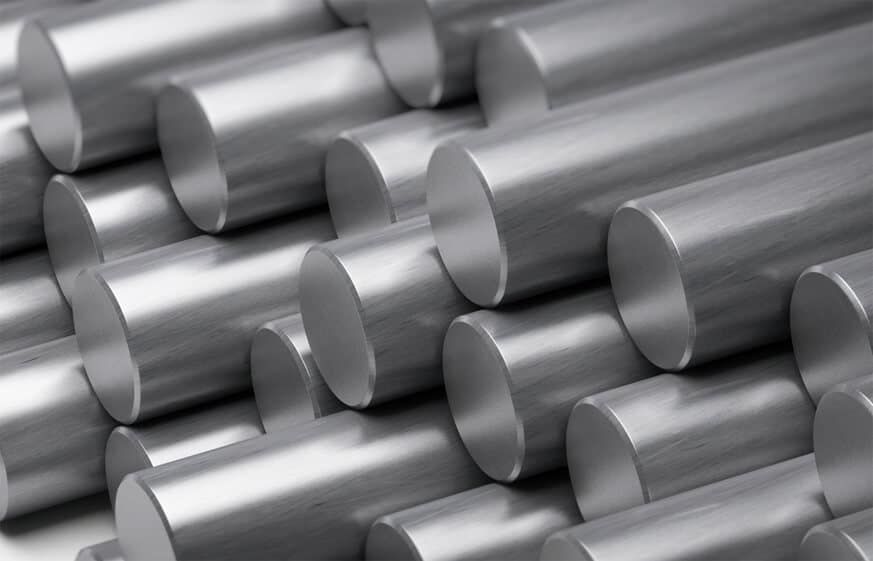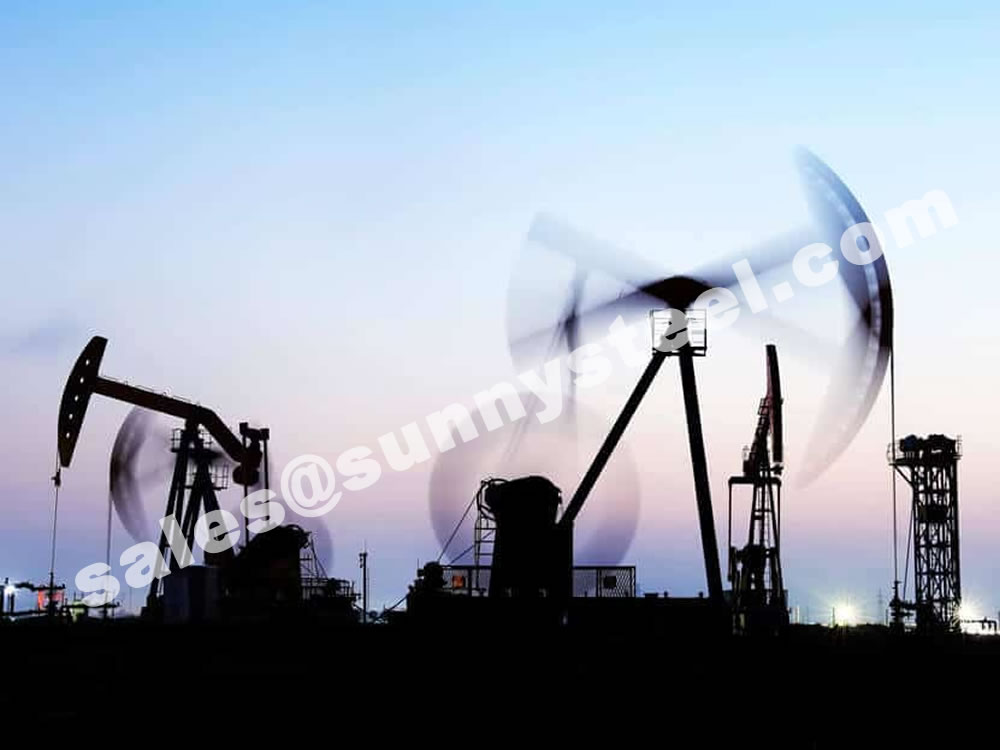410/HT Stainless Steel Plate
410/HT Stainless Steel Plate is the heat-treated version of Type 410 stainless steel.

Stainless Steel 410 410 is a martensitic stainless steel which is magnetic, resists corrosion in mild environents and has fairly good ductility.
410 stainless steel is a magnetic 11.5% minimum chromium all-purpose martensitic stainless steel providing favorable corrosion resistance and a broad scope of mechanical properties. The level of resistance can be enhanced by a process of heat treatment and is ideal for jobs requiring good corrosion resistance and high strength. 410 Stainless is a versatile grade due to its heat-treatability and its resistance to chemical atmospheric conditions.
410 stainless steel is magnetic in all conditions. Pre-heated to ~400°F to prevent cracks, then commonly heat-treated at ~2000°F, 410 stainless steel offers superior versatility. We offer 410 in the QDT condition, which offers high tensile & yield strength, and elongation.
Stainless Steel 410 is part of the martensitic family of stainless steels. It contains high chromium content, which provides corrosion resistance, and is often heat-treated to improve its hardness and strength. The material is magnetic in both annealed and hardened conditions, making it unique compared to austenitic grades like 304 or 316.
410 stainless steel is a versatile grade with good strength and corrosion resistance, making it suitable for a wide range of industries.
Stainless Steel 410 is a versatile martensitic stainless steel that offers high strength, hardness, and moderate corrosion resistance. It is widely used in industries such as automotive, petroleum, and manufacturing, where wear resistance and mechanical strength are essential.
AISI 410 stainless steel is a martensitic stainless steel known for its moderate corrosion resistance and good strength. It is magnetic and can be hardened through heat treatment.
410 is a martensitic stainless steel that is magnetic, resists corrosion in mild environments and has fairly good ductility. 410 pipe is used where abrasion and wear resistance is needed, combined with fair resistance to general corrosion and oxidation.
Resistance to chemical
atmospheric conditions
Good corrosion
resistance
High
strength
Resistant to mild corrosive environments but less so compared to austenitic grades like 304 or 316.
Can be welded using conventional methods but requires preheating and post-weld annealing to prevent cracking.
Easy to machine in annealed condition but becomes more difficult when hardened.
Stainless Steel 410 is a martensitic stainless steel known for its excellent mechanical properties, including high strength, good hardness, and moderate corrosion resistance. It is often used in applications where wear and tear, combined with the need for corrosion protection, are critical.
Heat treating stainless steel improves its corrosion resistance and achieves high strength levels while still retaining good toughness and ductility.
410 stainless steel in the quenched and double tempered (QDT) condition provides an optimal balance of strength, hardness, and corrosion resistance for demanding applications, including those in the oil and gas industries.
In the QDT condition, 410 SS has a hardness between 207 and 235 BHN, making it suitable for heavy-duty applications due to its abrasion resistance.
When heat-treated, 410 stainless steel provides excellent corrosion resistance to mild chemicals, water, and atmospheric conditions.
Due to its resistance to corrosion, 410 stainless steel is commonly used in human interactive environments such as cutlery, kitchen utensils, and dental equipment.
For 410 stainless steel’s best corrosion resistance to synthetic settings, it is crucial that the surface of 410 be free of all heat and oxide build up from construction, annealing, or treatment.
The martensitic, magnetic alloy 410 contains between 11.5 and 13.5% chromium, as well as nickel, manganese, silicon, carbon, phosphorus, sulfur, and iron.
| C | Cr | Mn | Ni | P | S | Si |
|---|---|---|---|---|---|---|
| Max | Max | Max | Max | Max | ||
| 0.15% | 11.5% - 13.5% | 1.0% | 0.5% | 0.04% | 0.03% | 0.75% |
Alloy 410 (UNS S41000) is a 12% chromium martensitic stainless steel plate that can be heat treated to obtain a wide range of mechanical properties.
| Material | Tempering Temp °C (°F) | 0.2 % Yield Strength (Mpa) | Ultimate Tensile Strength (Mpa) | % Elongation in 2" | % Reduction of Area | Charpy V Notch Impact Strength (J) | Hardness Brinell |
|---|---|---|---|---|---|---|---|
| Alloy 410 Bar Hardened 1850°F (1010°C) 30 mins, oil quench, tempered 4 Hrs |
260 (500) | 1089 | 1331 | 17 | 62 | 76 | 401 |
| Alloy 410 Bar Hardened 1850°F (1010°C) 30 mins, oil quench, tempered 4 Hrs |
317 (700) | 1069 | 1296 | 17 | 60 | 66 | 401 |
| Alloy 410 Bar Hardened 1850°F (1010°C) 30 mins, oil quench, tempered 4 Hrs |
482 (900) | 1014 | 1303 | 18 | 58 | 38 | 401 |
| Alloy 410 Bar Hardened 1850°F (1010°C) 30 mins, oil quench, tempered 4 Hrs |
538 (1000) | 917 | 965 | 19 | 62 | 33 | 285 |
| Alloy 410 Bar Hardened 1850°F (1010°C) 30 mins, oil quench, tempered 4 Hrs |
593 (1100) | 724 | 827 | 20 | 63 | 52 | 248 |
| Alloy 410 Bar Hardened 1850°F (1010°C) 30 mins, oil quench, tempered 4 Hrs |
649 (1200) | 634 | 731 | 21 | 65 | 119 | 223 |
The table below provides the suitable alternative grades to 410 stainless steels:
| Grade | Reasons for choosing the grade |
|---|---|
| 416 | High machinability is required, and the lower corrosion resistance of 416 is acceptable. |
| 420 | A higher hardened strength or hardness than can be obtained from 410 is needed. |
| 440C | A higher hardened strength or hardness than can be obtained even from 420 is needed. |
410 stainless steel offers several benefits that make it a popular choice across industries, including oil and gas, automotive, and manufacturing.
Grade 410 stainless steels are resistant to hot gases, steam, food, mild acids and alkalies, fresh water and dry air. These steels obtain maximum corrosion and heat resistance through hardening. However, grade 410 steels are less corrosion resistant than austenitic grades and grade 430 ferritic alloys containing 17% chromium. Smooth surface finish offers improved performance of steels.
Grade 410 steels have good scaling resistance at temperatures of up to 650 °C. However, the mechanical properties of the material will tend to reduce at temperatures ranging from 400 to 580 °C.
Annealing - Grade 410 steels can be fully annealed at temperatures from 815 to 900 °C, followed by slow furnace cooling and air-cooling. Process annealing of grade 410 steels can be carried out at temperatures ranging from 650 to 760 °C and air-cooled.
Hardening – Hardening of grade 410 steels can be performed at 925 to 1010 °C, followed by air and oil quenching. Heavy sections of grade 410 need to be oil quenched. Tempering, to enhance the mechanical properties and hardness of grade 410 steels, follows this process. It is not recommended to perform tempering at temperatures from 400 to 580 °C.
Grade 410 steels can be welded using all conventional welding techniques, but the materials should pre-heated at 150 to 260 °C followed by post-weld annealing treatment, to mitigate cracking. Grade 410 welding rods are recommended for tempering and post-hardening. In the "as welded" conditions, grade 309 filler rods can be used to achieve a ductile joint.
According to AS 1554.6 standards, grade 309 electrodes or rods are preferred for welding 410 steels.
Grade 410 steels can be easily machined in highly tempered or annealed conditions. However, it is hard to machine grade 410 steels if they are hardened above 30HRC. Free machining grade 416 is the best alternative.
We provide a variety of services when processing 410 stainless bar stock and other metals so that we can supply you with the products that meet your exact specifications.
For your 410 stainless order, we offer a number of value-added services to save you time and money. Our capabilities include:
Steel alloys like 410ss vary in composition, properties, and suitability for certain applications. Regardless of the alloy you choose, stainless steel offers excellent, reliable performance in your industry.
Compared to 410 steel’s composition, 304 stainless steel contains a higher percentage of chromium and nickel, giving it higher corrosion resistance, strength, and temperature resistance than 410 stainless.
However, 304 stainless steel comes at a higher price point, and 410 still offers good heat resistance and machinability. 304 stainless steel is commonly used in automotive applications, as well as in valves, dies, screws, and fasteners.
316 stainless steel contains molybdenum, which increases its corrosion resistance and improves its mechanical properties. Suitable for marine or coastal environments, 316 steel resists chloride ion corrosion or saltwater corrosion.
For applications that require moderate corrosion resistance, 410 stainless steel is a cost-effective alternative to 316 that provides good overall performance. Like 304 stainless steel, 316 is suited for valves, dies, screws, and fasteners.
While 420 steel is more durable and stronger than 410 stainless steel, 410 is better suited for applications that require precision machining due to its ductility.

SS 410 is corrosion resistant to some chemicals, foods, mild acids, water and air. It also demonstrates adequate resistance to nitric acid, concentrated sulphuric acid, dilute acetic acid and naphtha.
Our stainless steel bar stock lengths range from the industry standard 12' to 28' long. For projects requiring long length stainless steel bar, our inventory ranges from 20’-28’ R/L.
Quality Stainless Steel (SS) products are a top priority at Best Stainless. Our Stainless Steel 410 bar is a basic martensitic grade containing 11.5% chromium, which provides both exceptional wear and corrosion resistance. Improved mechanical properties and corrosion resistance are achieved with 410 stainless steel when it's hardened and tempered.
Our 410 stainless steel can be used in applications such as dental and surgical instruments, pipelines, valves and nozzles, automotive parts and more. 410 SS is generally used in applications where mild corrosion, high strength and heat resistance are required. Depending on the application and performance requirements, we also offer a 410 stainless steel equivalent, CA15.
Alro stocks 410 stainless steel, a soft and ductile variety of stainless steel. This type 410 (martensitic) stainless steel strip is the most versatile and widely used of all the martensitic grades of stainless steel. In its annealed condition, it can be drawn, formed or shaped. As it is an air or oil quench hardening grade, subsequent heat treatments can be applied to achieve high strength levels. While Type 410 offers excellent resistance to scaling up to 1200 degrees F. and boasts impressive mechanical properties, it is not recommended for applications where severe corrosion is a concern. Type 410 is a popular choice for springs, scrapers, fasteners, hardware brackets, furnace parts and burners. It is magnetic in all conditions.

With its combination of strength, hardness, and corrosion resistance, 410 stainless steel is utilized across a diverse range of industries and applications. Some common uses for 410 stainless include:

When you partner with Sunny Steel, you can stop worrying about meeting deadlines thanks to our responsive and timely service. You'll also say goodbye to unnecessary shopping around. Instead, you'll get white glove service from an expert who understands your needs and can get you the materials you need quickly.
